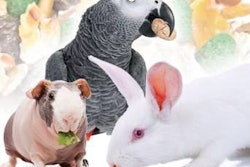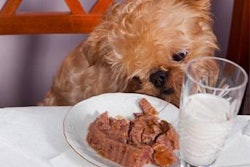No surprise, but financial analysts focused on the agricultural sector are starting to predict lower supplies -- and thus, higher prices -- for meat in 2013, especially for beef, according to Reuters. That will likely push more consumers to buy chicken and pork, making those meat sources also in shorter supply for petfood producers.
As we know, this is a domino effect from higher feed prices for production animals, which is in turn an effect of the drought that devastated the US Midwest this past summer, the worst in more than 50 years. Corn, the most common feed grain, reached US$8.43 a bushel in August, a record. Even the current level, US$7.23 a barrel, means the price of corn has nearly doubled in the past three years, Reuters says, at least partially from its use by the biofuels industry.
And, speaking of bracing yourself, that August record may soon be obliterated: One analyst, Dan Basse, president of AgResource, predicted that US corn could hit US$9 a bushel within the next six months as the effects of the drought continue to reverberate, global demands continue to increase and supplies of other grains, such as wheat, continue to decline along with corn. (Agriculture.com reported that Basse gave this prediction to Dow Jones Newswires during a global grain conference in Geneva, Switzerland, this week.)
The bottom line is this, according to analysts interviewed by Reuters:
- To date, farmers and producers have absorbed their rising feed costs by cutting back on production of livestock, especially cattle, and/or by operating at a loss. The number of cattle leaving feedlots could taper off noticeably as early as January or February.
- This will be followed by a reduction in pork supply by May or June.
- While US retail prices for pork and beef have remained stable so far, producers will eventually have to pass on their rising feed costs to consumers to avoid further losses, thus driving consumers to buy less expensive meat, such as chicken.
While global poultry production is projected to increase by nearly 2% by the end of this year, the high feed costs are impacting poultry producers, too, and could inhibit further production growth, especially in developed countries, according to WattAgNet.com.
So, the wisest bet for petfood producers might be to continue to seek alternative protein sources for their products. One option is lamb, because sheep are usually grass-fed, Reuters reports.
Petfood Forum 2013, scheduled for April 15-17 in the Chicago area, will include conference sessions on innovative ingredients for petfoods. In addition, on April 17-18, Petfood Workshop 2013 will focus on ingredients and include a breakout session on ingredient sourcing, specifically on how to find and safely source alternatives to common ingredients that are now dwindling in supply and rising in price.
Meanwhile, perhaps our industry needs to continue the innovation it has become known for during its rapid growth over the past decade and come up with new ways to find ingredients.

















